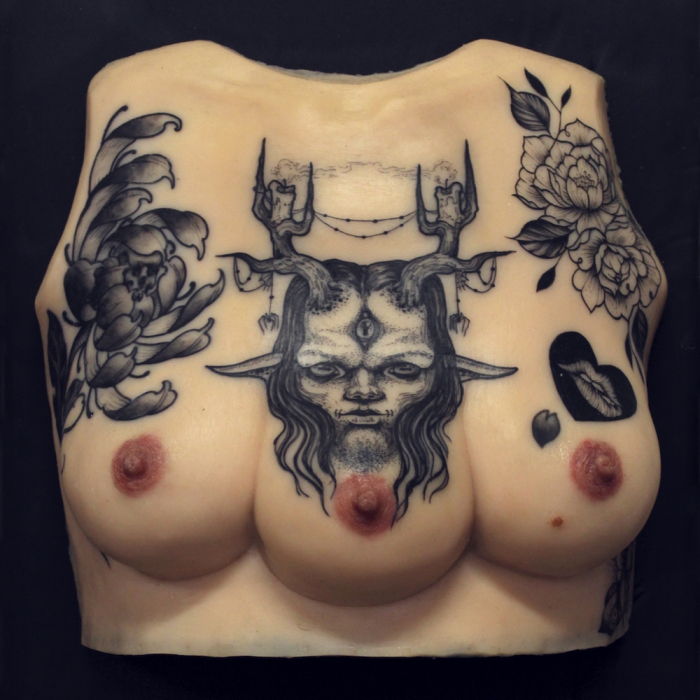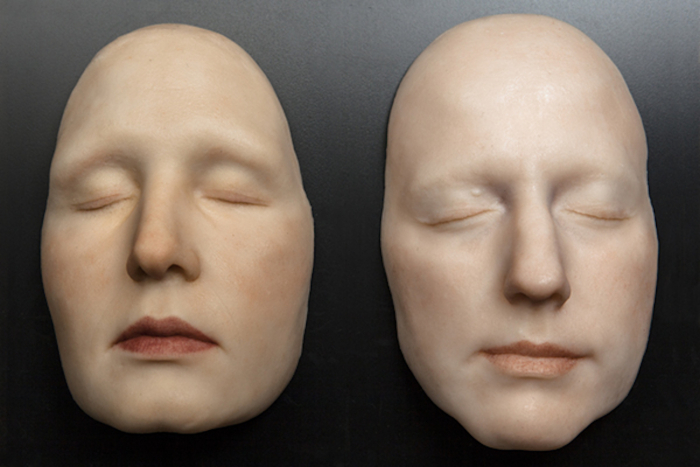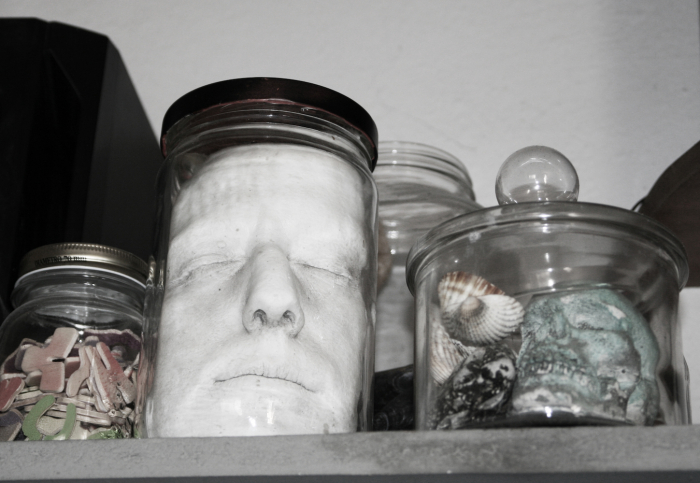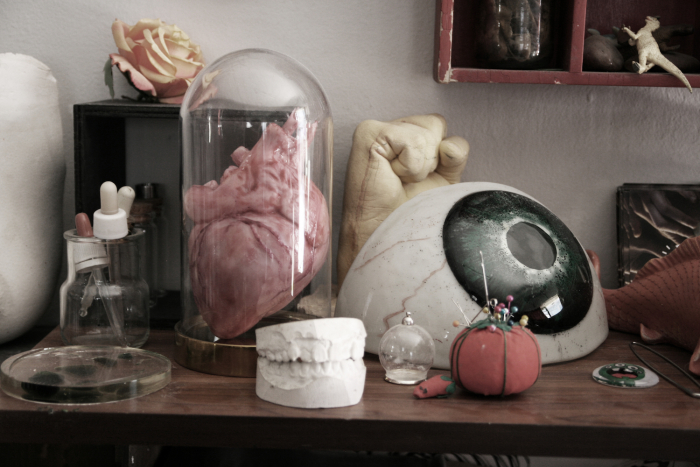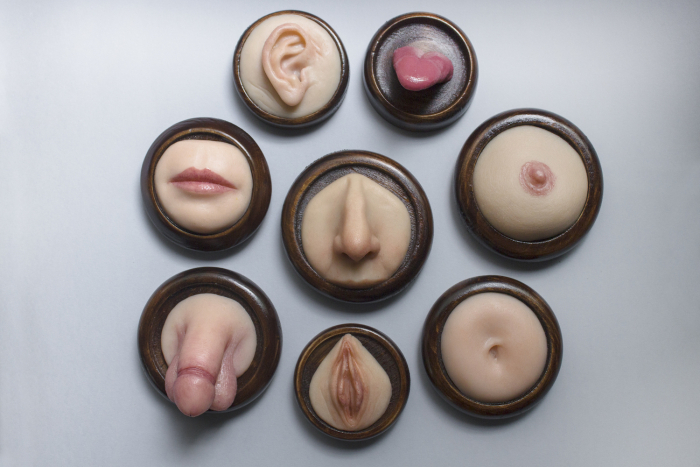CRISIPLASTICA
by Lina Vergara Huilcamán
Cristina welcomes me into what she calls her Wunderkammer, Casa Creativa (Creative Home), a coworking space she shares with other artists. I had seen her artworks at Mirabilia and I had always wondered who was behind those framed noses, eyes, vaginas and mouths. I like asking people how they manage—sometimes through oceans and storms—to make their dreams come true or at least to swim towards them, perhaps because I have never been brave enough to try and achieve my dreams, and in their stories I see a possible continuation of mine.
“My beginnings were troubled, unfortunately I didn’t attend an art school nor an academy, I studied tourism. I lived in the suburbs at the time and the only way to reach the art school was through complicated transportation routes, and moreover all my female friends headed in the other direction… but in my garage I have always worked with my hands: papier-mâché, paper collage… on my own. I come from a family of artisans, my aunt was a tailor, my father was a worker who every now and then made small wood sculptures or drew on his notebooks. Maybe it is precisely from them that I have inherited my creative artistic streak and, although at the beginning I considered art as a hobby, like my father, I also felt the heaviness and frustration of my parents working in a factory. I didn’t want a job I didn’t like and I also wanted to do something that felt like mine. At a certain point, after finishing school and doing a few of the typical jobs for young people, such as telemarketing, I attended a stage and scenic design course at the Scuole Tecniche San Carlo, a year-long school where, beyond theory, which is very interesting, I practiced a lot in a workshop. Then I did my internship, as required by the school, in Turin, working with special effects expert Michele Guaschino, and after that I have been working with him as a workshop assistant for five years, until I decided to go my own way. Basically, my job is the same as before but now I am self-employed.
I have always been fond of anatomy, I love to buy books, visit anatomical museums and with Guaschino I have learnt the techniques of hyperrealism, I have learnt how to create different textures, to try and reproduce the translucency of human skin with artificial materials. The job I have chosen is not an easy one, because of the peculiarities of the phases of making, the technical difficulties, the necessity of experimenting, which requires the use of expensive materials. I wish I had enough time and money to lock myself in my room and experiment. Luckily, thanks to contemporary technologies and social networks, I can see the experiences of many other people, do research and also learn things that I would never be able to get to otherwise. The big problem I often have to face is: shall I do something I like or just something that sells? I must say that the decisions I have made so far are not that profit-oriented, but I decorously live with my choice. It’s hard to make yourself known and survive in a market where you can find so much of anything and a lot of beautiful stuff as well, doing something which people are not accustomed to, and moreover with grotesque items they would hardly be willing to put into their houses. I’d better work hard on communication, but I cannot rely on a company and as a human being I only have a limited amount of time. Luckily there are a few people who love and help me, such as my photographer friend. I consider myself as an artisan, who works plastic materials with her hands. You ask me for something and I make it: sculptures, anatomical reproductions, masks, food… in resin, in silicone. I reproduce the human body through cast from life, which is a very interesting technique. I made a cast from the hand of my grandad, who was a carpenter. I also make the cast of faces and all those who have tried this say that it is almost a mystical experience, because for half an hour you are isolated from sounds and light… you lose your balance, some people fall asleep and when I am done and perform the scalpel cut and the face wriggles out to go back to the reality of sounds and colours, it feels like a childbirth. A man who had suffered from a heart condition and had been feeling very bad, once recovered, decided to make a cast of his face to keep memory of this personal experience and remember the moment. I do not use plaster, that’s out of question, I use alginate, the same material used by dentists.
One day, I started to think about making anatomical parts as decorations, objects, sculptures. They looked very grotesque at the beginning, somehow reminding the crime scene left by a serial killer: a lamp made of human skin with hair and veins… a sausage in the shape of a sliced penis, in honour of Lorena Bobbit, to some extent a conceptual, liberating artwork. Then I came to create framed anatomical parts such as eyes, nose, mouth, ear, navel, vagina, penis… or an entire bust with three breasts, tattooed and framed. Yes, silicone can be tattooed just like real skin.
(Good heavens! All of a sudden, all my inhibitions disappear and I see in front me, hanging on a wall in my house, my own face with a big eye tattooed on my forehead and big eyelashes falling down on my cheeks…)
Hyperrealism is a new (yet not so very recent) form of representing reality and the cutting-edge materials involved in the latest technology confront us with consistencies and definitions which ensure a very good rendition of complexions, textures and the impression of a visually soft skin, and in front of such a blatant representation of the real thing (although it is just simple anatomy), people are always surprised, fascinated or disgusted. To me, the skin—even if flabby—moles, imperfections, the age, the shape of a young or a sagging body mean truth and therefore beauty.”
How much would you be willing to pay for a unique piece representing yourself or the object of your desire?
Before answering, however, we should consider the cost of materials, of the tests needed to get the best outcome, of the colouring, the base or frame or vase, of all the working hours it takes to create that particular object, and the artistic value that this unique, handmade object may have.
What value would I put to the amazing possibility of having a jar full of vinegar with my hand inside, or my and my boyfriend’s heads inside a fish tank, together, for ever… and what if I wanted a collection of my favourite feet on the wall, ready to be taken down and kissed in any moment of free intimacy?
Today’s pragmatic and severe world has lost some of its limits, I feel the wind of freedom and of fantastic desire flowing around me. A small reproduction that makes me happy, just for me and my wonder-room.

